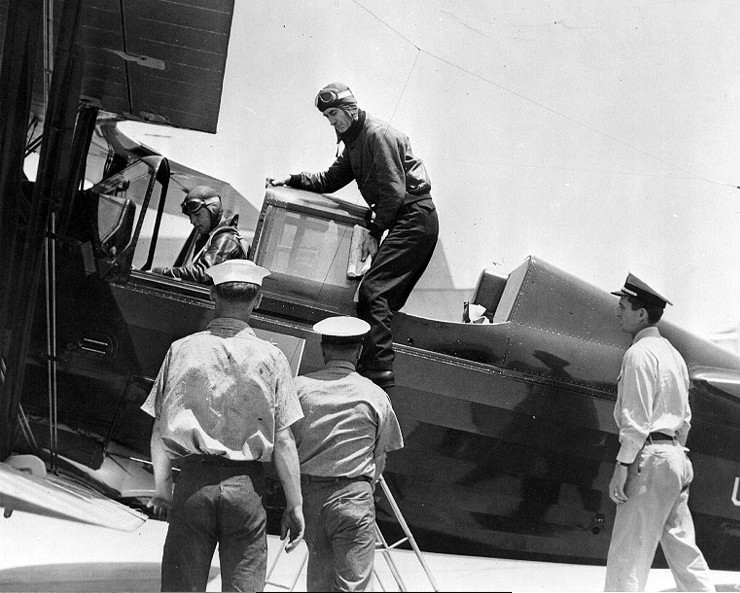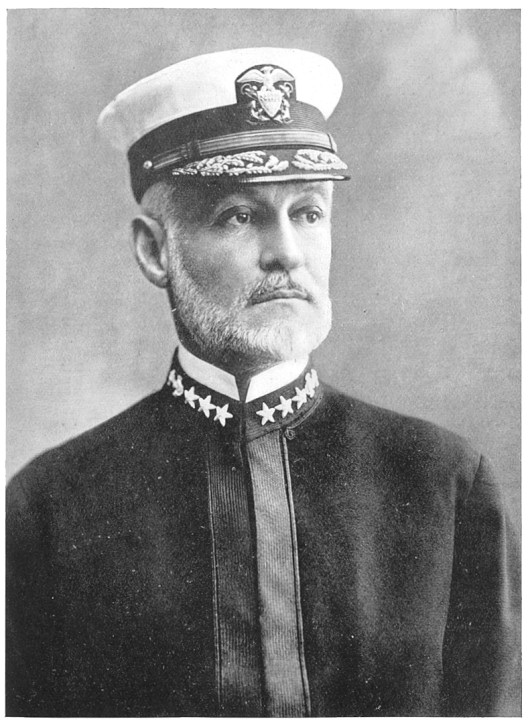|
Wilson Brown (admiral)
Wilson Brown, Jr. (27 April 1882 – 2 January 1957) was a vice admiral of the United States Navy who served in World War I and World War II. Brown turned 60 in April 1942, making him one of the oldest American naval officers to serve in combat during World War II. Biography Early career Brown, born in Philadelphia on 27 April 1882, graduated from the Naval Academy in 1902 standing 44th in a class of 59. During World War I he served on the staff of Admiral William S. Sims in London, and commanded the destroyer . In 1921 he completed the Naval War College course and was promoted to the rank of commander; he then served as the executive officer of the battleship , before becoming aide to Presidents Calvin Coolidge and Herbert Hoover. In 1929 he was appointed Commander of the New London Submarine Base, and was promoted to captain in 1932, taking command of the battleship . In 1934 he became chief of staff of the Naval War College, and in 1936 he achieved flag rank as rear admiral ... [...More Info...] [...Related Items...] OR: [Wikipedia] [Google] [Baidu] |
Philadelphia
Philadelphia, often called Philly, is the largest city in the Commonwealth of Pennsylvania, the sixth-largest city in the U.S., the second-largest city in both the Northeast megalopolis and Mid-Atlantic regions after New York City. Since 1854, the city has been coextensive with Philadelphia County, the most populous county in Pennsylvania and the urban core of the Delaware Valley, the nation's seventh-largest and one of world's largest metropolitan regions, with 6.245 million residents . The city's population at the 2020 census was 1,603,797, and over 56 million people live within of Philadelphia. Philadelphia was founded in 1682 by William Penn, an English Quaker. The city served as capital of the Pennsylvania Colony during the British colonial era and went on to play a historic and vital role as the central meeting place for the nation's founding fathers whose plans and actions in Philadelphia ultimately inspired the American Revolution and the nation's inde ... [...More Info...] [...Related Items...] OR: [Wikipedia] [Google] [Baidu] |
Herbert Hoover
Herbert Clark Hoover (August 10, 1874 – October 20, 1964) was an American politician who served as the 31st president of the United States from 1929 to 1933 and a member of the Republican Party (United States), Republican Party, holding office during the onset of the Great Depression in the United States. A self-made man who became rich as a mining engineer, Hoover led the Commission for Relief in Belgium, served as the director of the U.S. Food Administration, and served as the U.S. Secretary of Commerce. Hoover was born to a Quaker family in West Branch, Iowa, but he grew up in Oregon. He was one of the first graduates of the new Stanford University in 1895. He took a position with a London-based mining company working in Australia and China. He rapidly became a wealthy mining engineer. In 1914 at the outbreak of World War I, he organized and headed the Commission for Relief in Belgium, an international relief organization that provided food to occupied Belgium. When the ... [...More Info...] [...Related Items...] OR: [Wikipedia] [Google] [Baidu] |
Ernest King
Ernest Joseph King (23 November 1878 – 25 June 1956) was an American naval officer who served as Commander in Chief, United States Fleet (COMINCH) and Chief of Naval Operations (CNO) during World War II. As COMINCH-CNO, he directed the United States Navy's operations, planning, and administration and was a member of the Joint Chiefs of Staff. He was the United States Navy's second most senior officer in World War II after Fleet Admiral William D. Leahy, who served as Chief of Staff to the Commander in Chief. Born in Lorain, Ohio, King served in the Spanish–American War while still attending the United States Naval Academy. He received his first command in 1914, leading the destroyer in the occupation of Veracruz. During World War I, he served on the staff of Vice-Admiral Henry T. Mayo, the commander of the United States Atlantic Fleet. After the war, King served as head of the Naval Postgraduate School, commanded a submarine squadron, and served as C ... [...More Info...] [...Related Items...] OR: [Wikipedia] [Google] [Baidu] |
Chief Of Naval Operations
The chief of naval operations (CNO) is the professional head of the United States Navy. The position is a statutory office () held by an admiral who is a military adviser and deputy to the secretary of the Navy. In a separate capacity as a member of the Joint Chiefs of Staff (), the CNO is a military adviser to the National Security Council, the Homeland Security Council, the secretary of defense, and the president. The current chief of naval operations is Admiral Michael M. Gilday. Despite the title, the CNO does not have operational command authority over naval forces. The CNO is an administrative position based in the Pentagon, and exercises supervision of Navy organizations as the designee of the secretary of the Navy. Operational command of naval forces falls within the purview of the combatant commanders who report to the secretary of defense. Appointment, rank, and responsibilities The chief of naval operations (CNO) is typically the highest-ranking officer on ... [...More Info...] [...Related Items...] OR: [Wikipedia] [Google] [Baidu] |
New Guinea
New Guinea (; Hiri Motu: ''Niu Gini''; id, Papua, or , historically ) is the world's second-largest island with an area of . Located in Oceania in the southwestern Pacific Ocean, the island is separated from Australia by the wide Torres Strait, though both landmasses lie on the same continental shelf. Numerous smaller islands are located to the west and east. The eastern half of the island is the major land mass of the independent state of Papua New Guinea. The western half, known as Western New Guinea, forms a part of Indonesia and is organized as the provinces of Papua, Central Papua, Highland Papua, South Papua, Southwest Papua, and West Papua. The largest cities on the island are Jayapura (capital of Papua, Indonesia) and Port Moresby (capital of Papua New Guinea). Names The island has been known by various names: The name ''Papua'' was used to refer to parts of the island before contact with the West. Its etymology is unclear; one theory states that ... [...More Info...] [...Related Items...] OR: [Wikipedia] [Google] [Baidu] |
Owen Stanley Range
Owen Stanley Range is the south-eastern part of the central mountain-chain in Papua New Guinea. Its highest point is Mount Victoria at , while its most prominent peak is Mount Suckling. History Owen Stanley Range was seen in 1849 by Captain Owen Stanley while surveying the south coast of Papua and named after him. The eastern extremity of the range is Mount Victoria, which was climbed by Sir William MacGregor in 1888, and it extends as far west as Mount Thynne and Lilley. But the name is generally used to denote the whole of the chain of the Papuan Peninsula, from Mount Chapman to the south-eastern end of the island, and to include Mount Albert Edward which is really separated from it by the Wharton Chain. Geography The range is flanked by broken and difficult country, particularly on the south-western side. There are few practicable passes, the easiest being the famous Kokoda Track which crosses the range between Port Moresby and Buna and was in use for more than 50 y ... [...More Info...] [...Related Items...] OR: [Wikipedia] [Google] [Baidu] |
Invasion Of Lae-Salamaua
An invasion is a military offensive in which large numbers of combatants of one geopolitical entity aggressively enter territory owned by another such entity, generally with the objective of either: conquering; liberating or re-establishing control or authority over a territory; forcing the partition of a country; altering the established government or gaining concessions from said government; or a combination thereof. An invasion can be the cause of a war, be a part of a larger strategy to end a war, or it can constitute an entire war in itself. Due to the large scale of the operations associated with invasions, they are usually strategic in planning and execution. History Archaeological evidence indicates that invasions have been frequent occurrences since prehistory. In antiquity, before radio communications and fast transportation, the only way for a military to ensure adequate reinforcements was to move armies as one massive force. This, by its very nature, led to the ... [...More Info...] [...Related Items...] OR: [Wikipedia] [Google] [Baidu] |
Rabaul
Rabaul () is a township in the East New Britain province of Papua New Guinea, on the island of New Britain. It lies about 600 kilometres to the east of the island of New Guinea. Rabaul was the provincial capital and most important settlement in the province until it was destroyed in 1994 by falling ash from a volcanic eruption in its harbour. During the eruption, ash was sent thousands of metres into the air, and the subsequent rain of ash caused 80% of the buildings in Rabaul to collapse. After the eruption the capital was moved to Kokopo, about away. Rabaul is continually threatened by volcanic activity, because it is on the edge of the Rabaul caldera, a flooded caldera of a large pyroclastic shield. Rabaul was planned and built around the harbour area known as Simpsonhafen (Simpson Harbour) during the German New Guinea administration, which controlled the region between 1884 and formally through 1919. Rabaul was selected as the capital of the German New Guinea administration ... [...More Info...] [...Related Items...] OR: [Wikipedia] [Google] [Baidu] |
Aviator
An aircraft pilot or aviator is a person who controls the flight of an aircraft by operating its directional flight controls. Some other aircrew members, such as navigators or flight engineers, are also considered aviators, because they are involved in operating the aircraft's navigation and engine systems. Other aircrew members, such as drone operators, flight attendants, mechanics and ground crew, are not classified as aviators. In recognition of the pilots' qualifications and responsibilities, most militaries and many airlines worldwide award aviator badges to their pilots. History The first recorded use of the term ''aviator'' (''aviateur'' in French) was in 1887, as a variation of ''aviation'', from the Latin ''avis'' (meaning ''bird''), coined in 1863 by in ''Aviation Ou Navigation Aérienne'' ("Aviation or Air Navigation"). The term ''aviatrix'' (''aviatrice'' in French), now archaic, was formerly used for a female aviator. These terms were used more in the ... [...More Info...] [...Related Items...] OR: [Wikipedia] [Google] [Baidu] |
Attack On Pearl Harbor
The attack on Pearl HarborAlso known as the Battle of Pearl Harbor was a surprise military strike by the Imperial Japanese Navy Air Service upon the United States against the naval base at Pearl Harbor in Honolulu, Territory of Hawaii, just before 8:00a.m. (local time) on Sunday, December 7, 1941. The United States was a neutral country at the time; the attack led to its formal entry into World War II the next day. The Japanese military leadership referred to the attack as the Hawaii Operation and Operation AI, and as Operation Z during its planning. Japan intended the attack as a preventive action. Its aim was to prevent the United States Pacific Fleet from interfering with its planned military actions in Southeast Asia against overseas territories of the United Kingdom, the Netherlands, and those of the United States. Over the course of seven hours there were coordinated Japanese attacks on the US-held Philippines, Guam, and Wake Island and on the B ... [...More Info...] [...Related Items...] OR: [Wikipedia] [Google] [Baidu] |
Scouting Fleet
The Scouting Fleet was created in 1922 as part of a major, post-World War I reorganization of the United States Navy. The Atlantic and Pacific fleets, which comprised a significant portion of the ships in the United States Navy, were combined into a new entity, the United States Fleet. Defined as "the principal naval force of the United States," the new fleet was composed of four elements: (a) the Battle Fleet, (b) the Scouting Fleet, (c) the Control Force, and (d) the Fleet Base Force. Under the general heading of "Forces Not Assigned to the United States Fleet" came six categories: (a) Asiatic Fleet; (b) Naval Forces, Europe; (c) Special Service Squadrons; (d) Submarine Divisions, Atlantic; (e) Submarine Divisions, Pacific; and (f) Naval District Forces. While there was a reorganization in 1930, and the renaming of the Battle Fleet and Scouting Fleet as the Battle Force and Scouting Force, this would be the core structure of the United States Navy until the beginning of World Wa ... [...More Info...] [...Related Items...] OR: [Wikipedia] [Google] [Baidu] |
List Of Superintendents Of The United States Naval Academy
The Superintendent of the United States Naval Academy is its commanding officer. The position is a statutory office (), and is roughly equivalent to the chancellor or president of an American civilian university. The officer appointed is, by tradition, a graduate of the United States Naval Academy. However, this is not an official requirement for the position. To date, all superintendents have been naval officers. No Marine Corps officer has yet served as superintendent. The United States Naval Academy is organized much like a civilian college. The Superintendent's principal deputies include overseeing a civilian Academic Dean, who manages the academic program and faculty, and the Commandant of Midshipmen, who serves as dean of students and supervisor of all military and professional training. The Superintendent, Commandant, Academic Dean, and academic division directors sit on the academic board, which sets the academy's academic standards. Superintendents A "—" in the Cl ... [...More Info...] [...Related Items...] OR: [Wikipedia] [Google] [Baidu] |









